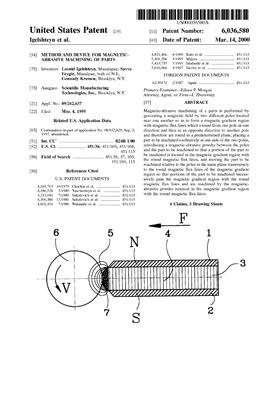Igelshteyn L., Feygin S., Kremen G.; заявитель и патентообладатель:
Scientific Manufacturing Technologies. – МКИ: B24B 1/00; НКИ
451/
36. – № 09/262637; заяв. 04.03.1999; опубл.
14.03.2000. – 7 с. Формула изобретения (на англ. яз.):
A method of magnetic-abrasive machining of a parts, comprising the steps of generating a magnetic field by two different poles located near one another so as to form a magnetic gradient region with magnetic flux lines which extend from one pole in one direction and then in an opposite direction to another pole and therefore are round in a predetermined plane; placing a part to be machined exclusively at one side of the two poles; introducing a magnetic-abrasive powder between the poles and the part to be machined so that a portion of the part to be machined is located in the magnetic gradient region with the round magnetic flux lines; and moving the part to be machined relative to the poles in the same plane transversely to the round magnetic flux lines of the magnetic gradient region so that portions of the part to be machined successively pass the magnetic gradient region with the round magnetic flux lines and are machined by the magnetic-abrasive powder retained in the magnetic gradient region with the round magnetic flux lines.
36. – № 09/262637; заяв. 04.03.1999; опубл.
14.03.2000. – 7 с. Формула изобретения (на англ. яз.):
A method of magnetic-abrasive machining of a parts, comprising the steps of generating a magnetic field by two different poles located near one another so as to form a magnetic gradient region with magnetic flux lines which extend from one pole in one direction and then in an opposite direction to another pole and therefore are round in a predetermined plane; placing a part to be machined exclusively at one side of the two poles; introducing a magnetic-abrasive powder between the poles and the part to be machined so that a portion of the part to be machined is located in the magnetic gradient region with the round magnetic flux lines; and moving the part to be machined relative to the poles in the same plane transversely to the round magnetic flux lines of the magnetic gradient region so that portions of the part to be machined successively pass the magnetic gradient region with the round magnetic flux lines and are machined by the magnetic-abrasive powder retained in the magnetic gradient region with the round magnetic flux lines.

